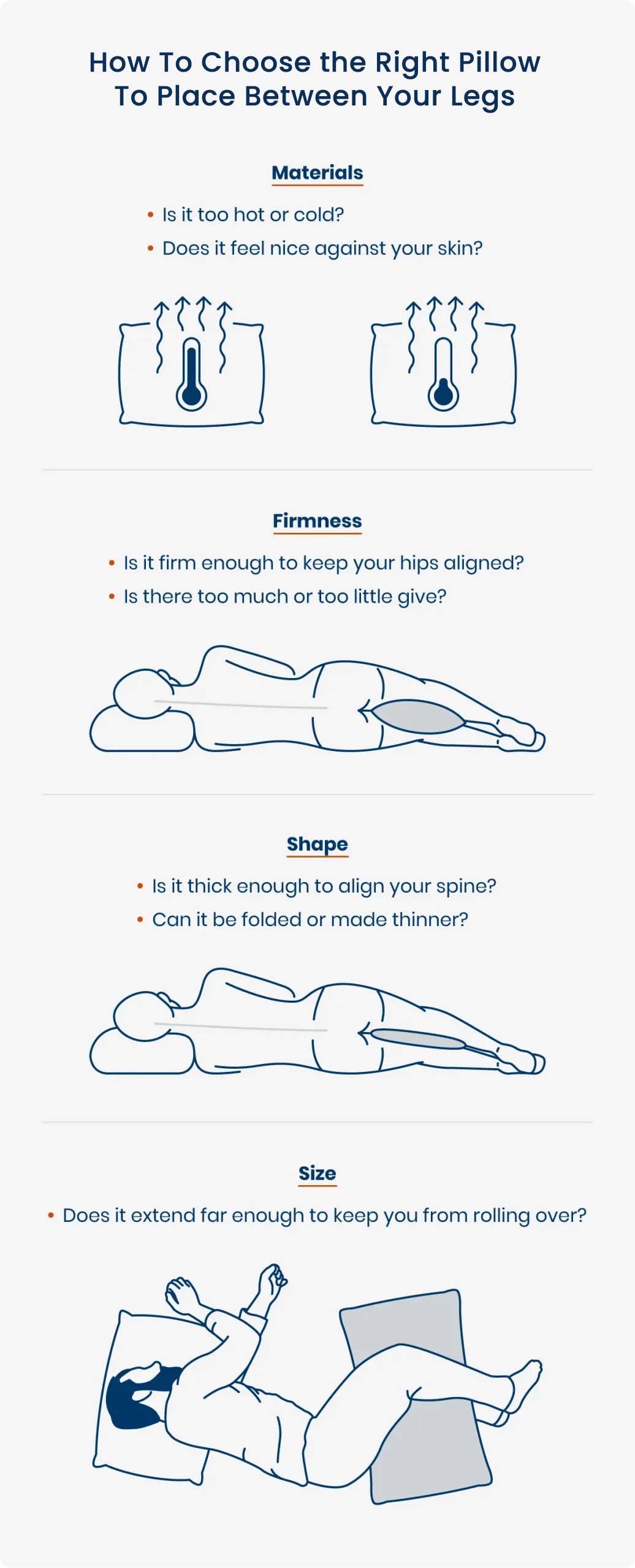There’s no one "right" way to sleep, but there are some things you can do to improve your comfort and quality of sleep. For example, the position you sleep in can affect how well you sleep and how you feel when you wake up. Sleeping with a pillow between your legs can have a big impact, too.
What does sleeping with a pillow between your legs do? While something so small might not seem like it could have a huge impact on your sleep, you might be surprised. Let’s take a look at some of the many benefits and how to choose the right pillow for you.

1. Can Help You Sleep Better During Pregnancy
If you’re pregnant, you know just how difficult it can be to get a good night’s sleep and to wake up without body aches and pains. One study found that 84% of pregnant and postpartum women experienced sleep problems several times a week.
Using a pregnancy pillow has health benefits and can help you find and stay in a more comfortable sleeping position. Lying on your side with a pillow between your legs can make you more comfortable and help prevent you from switching to a less comfortable position.
2. Can Help Relieve Lower Back Pain
Getting rid of lower back pain can be extremely difficult. While a pillow won’t solve all back problems, sleeping with a pillow between your legs can help reduce the tension and stress on your lower back and pelvis. Better alignment can help stop muscles from fatiguing and decrease lower back pain during the day.
3. May Improve Spinal Alignment
If your bed is too hard or soft or if you aren’t sleeping in a position that allows for optimal sleep posture, you may have a sore back when you wake up. That’s because your spine isn’t properly aligned, which can lead to strained back and core muscles.
Placing adjustable pillows between your legs when you sleep can have several health benefits, including keeping your neck and spine in better alignment.
4. May Improve Circulation and Breathing at Night
Proper spinal alignment can help improve circulation throughout the body, and sleeping with a pillow between the legs can help maintain that alignment. Breathing better means better, more restful sleep, and improved circulation helps keep your cells oxygenated. Your circulatory system is just one of the many body parts that are affected during pregnancy, so using a pillow between your legs can help your circulation.
5. May Reduce Muscle Cramps
Leg cramps can happen to anyone, including pregnant people, and they can be very painful. Sleeping with a pillow between your legs can help reduce the number of muscle cramps you deal with. Sleeping this way can improve circulation and reduce pressure on the muscles, stopping or reducing pregnancy cramps before they start.
6. May Reduce Hip and Joint Pressure
Sleeping on your back or stomach can put pressure on your hips and other joints, leading to pain and poor sleep. Using a pillow between your legs can help keep you in a side sleeping position, which in turn helps reduce pressure on ligaments, muscles, and tendons. If you experience hip pain and you’re already a side sleeper, placing a pillow between your legs may still improve the position of your hips during sleep, whether you’re pregnant or not.
7. Can Help Keep You in a Better Sleeping Position
Because your body keeps working as you sleep, everything from your gut health to back pain can be impacted by the position you’re in. One of the biggest health benefits of using a body pillow or another pillow between your legs is that it can help keep you in a healthier position as you sleep.
8. May Help Improve Posture
By sleeping in a position that properly orients your spine, you may see improvements in how you sit and stand during your waking hours. By more evenly distributing your weight and reducing the strain on your back and hips, your core and back muscles will be less strained and tired. This can help you maintain better posture and may reduce pregnancy back pain.
9. Might Alleviate Pain From Sciatica and Herniated Discs
Sciatica and herniated discs can be a source of constant pain and discomfort. These conditions make everyday life difficult but can also cause problems for your sleep — and poor sleep can make back pain worse. It’s a difficult cycle to break, but using a pillow to improve spinal alignment may help decrease sciatica and herniated disc pain by reducing pressure on those painful areas. A pillow between your legs may not prevent chronic pain, but it may offer you enough relief that it’s easier to focus on other ways of improving these conditions, like physical therapy, diet, and exercise.
10. May Help Improve Sleep for People With Sleep Apnea
The Mayo Clinic cited a “host of evidence” that points to side sleeping as the optimal position to help prevent snoring and stop the airway from collapsing — a problem commonly found in people with sleep apnea. If you struggle to sleep on your side, using a pillow between your legs can help stop you from rolling over into a position where your airflow could be reduced.
How To Sleep With a Pillow Between Your Legs
Sleeping on your side with a pillow between your legs and a side-sleeper pillow can help with everything from neck, back, and shoulder pain to breathing problems. But to get the most out of this sleeping position, follow these tips:
- Lie down on your side, bend your knees, and bring them up slightly toward your chest.
- Place a pillow between your legs, either between your knees or thighs, and adjust it until it moves your hip into a neutral position. If you are using a thin pillow, you may need to fold it.
- If there is a gap between the mattress and your waist, you can put another pillow there to help improve spinal alignment.
How To Choose the Right Pillow
Finding the right pillow isn’t always easy. Everyone’s body and reasons for sleeping on their side are different. But with a little understanding of what’s important in a pillow that will rest between your legs, some research can help you pick one that will do the most good. Below are a few elements to weigh when choosing your pillow.
Material
Because the pillow you choose will be between your legs all night, it’s important to pick the right material. Not only will it need to be firm enough, but it also needs to be comfortable against your skin and maintain a comfortable temperature.
Solid memory foam usually offers to most consistent support, though shredded memory foam will conform better to your body. Other materials like feathers, wool, or synthetic fibers tend to compact more easily, which is okay if you don’t need a pillow that is too thick. Try experimenting with different material types to avoid the wrong pillow.
Firmness
The right pillow will be firm enough to adequately support the weight of your top leg as you sleep on your side without being so firm that it throws your hips out of alignment. Memory foam pillows can be a great way to strike this balance, but pillows with other kinds of filling will work, too.
Shape
For many people, a standard rectangular pillow will do the job of properly aligning their spine when they’re sleeping on their side. But for others, that shape just won’t cut it. Depending on your body and the issues you’re trying to alleviate with a pillow between your legs, you may need a different pillow shape. Some memory foam pillows can be folded into a thicker pillow, while pillows with other fillings can be flattened more easily if you need a thinner pillow.
Size
The size of a pillow is important, whether it’s resting under your head or between your knees. A good rule of thumb to keep in mind when shopping for a pillow is to make sure it's not too thick or thin and that it's long enough to extend in front of and behind your legs. That extra length will help stop you from rolling over onto your back or stomach.

Find the Right Pillow for Better, Healthier Sleep
Getting a better night’s sleep is a lot easier when you have the right pillows. A pregnancy pillow between the legs can help anyone (pregnant or not) improve the alignment of their spine and stay in a better sleeping position all night long. Add a specially designed side-sleeper pillow to further improve your comfort and sleeping position — you’ll be amazed at how much better you feel when you wake up in the morning.













